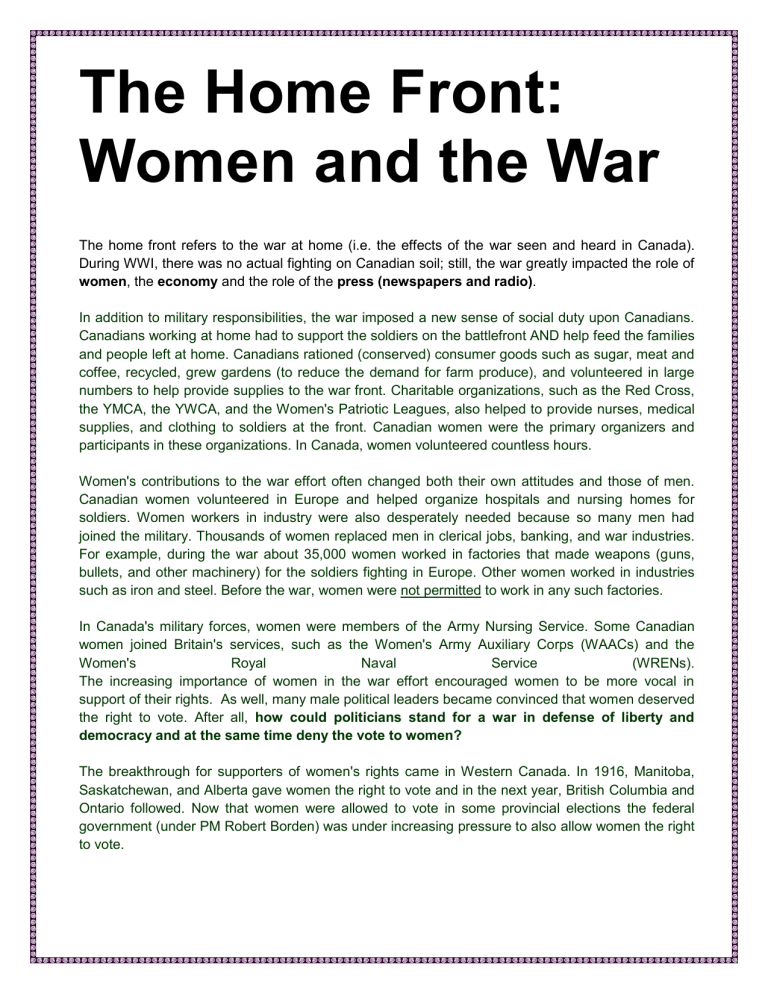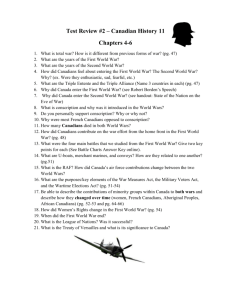
The Home Front: Women and the War The home front refers to the war at home (i.e. the effects of the war seen and heard in Canada). During WWI, there was no actual fighting on Canadian soil; still, the war greatly impacted the role of women, the economy and the role of the press (newspapers and radio). In addition to military responsibilities, the war imposed a new sense of social duty upon Canadians. Canadians working at home had to support the soldiers on the battlefront AND help feed the families and people left at home. Canadians rationed (conserved) consumer goods such as sugar, meat and coffee, recycled, grew gardens (to reduce the demand for farm produce), and volunteered in large numbers to help provide supplies to the war front. Charitable organizations, such as the Red Cross, the YMCA, the YWCA, and the Women's Patriotic Leagues, also helped to provide nurses, medical supplies, and clothing to soldiers at the front. Canadian women were the primary organizers and participants in these organizations. In Canada, women volunteered countless hours. Women's contributions to the war effort often changed both their own attitudes and those of men. Canadian women volunteered in Europe and helped organize hospitals and nursing homes for soldiers. Women workers in industry were also desperately needed because so many men had joined the military. Thousands of women replaced men in clerical jobs, banking, and war industries. For example, during the war about 35,000 women worked in factories that made weapons (guns, bullets, and other machinery) for the soldiers fighting in Europe. Other women worked in industries such as iron and steel. Before the war, women were not permitted to work in any such factories. In Canada's military forces, women were members of the Army Nursing Service. Some Canadian women joined Britain's services, such as the Women's Army Auxiliary Corps (WAACs) and the Women's Royal Naval Service (WRENs). The increasing importance of women in the war effort encouraged women to be more vocal in support of their rights. As well, many male political leaders became convinced that women deserved the right to vote. After all, how could politicians stand for a war in defense of liberty and democracy and at the same time deny the vote to women? The breakthrough for supporters of women's rights came in Western Canada. In 1916, Manitoba, Saskatchewan, and Alberta gave women the right to vote and in the next year, British Columbia and Ontario followed. Now that women were allowed to vote in some provincial elections the federal government (under PM Robert Borden) was under increasing pressure to also allow women the right to vote. The Home Front: Women and the War Questions 1. Explain what the term “the home front” means in your own words. 2. Complete the following chart: New Jobs for Women During the War Job Title Example #1: Factory Worker What did women do in these jobs? Job Description Why was this job important to the war effort? Conscription Crisis By 1917, the failure of voluntary recruitment in Canada to sustain a 500,000-man army was contributing to an atmosphere of national crisis, but not of despair. More and more Canadians now believed that the country was not simply fighting at Britain's side -- it had become Canada's war. In order to maintain Canada's strength, Borden announced that the conscription of men for national service had become a military necessity. The men at the front had to be reinforced. Borden also wanted Canada to have a voice in shaping imperial policy. To have that voice, Canada had to pull its weight. Canadian men, Canadian interests, and Canadian liberty were all at stake. The introduction of conscription in 1917 would provoke the greatest political crisis of the period. It would split the country along French-English lines. French Canadians had no sentimental attachment to France or to Britain, and they believed that Borden was indifferent to their interests. No separate French-Canadian divisions existed in the military, and French-Canadian officers were not promoted to senior positions. FrenchCanadian attitudes were also shaped by resentment of the treatment of Frenchspeaking minorities in Ontario and Manitoba. In both provinces, guarantees for French-language schools were overturned during the war. Partly in consequence, enlistments in Quebec were much lower than in the rest of Canada. Moreover, French Canadians did not believe that English Canadians cared about their concerns. In contrast, English Canadians did not believe that French Canadians were doing their duty by participating fully in the war effort. While English Canadians gave their lives, French Canadians had contributed only five per cent of all enlisted men, even though that province made up about one third of the national population. In the spring of 1917, when more than 20,000 Canadian casualties were recorded in Europe, Quebec produced less than 100 volunteers. Many English Canadians talked about forcing French Canadians to contribute their share at home and abroad. Prime Minister Robert Borden chose to support Canada's fighting troops and the war effort by passing the Military Service Act. It basically made all men between 20 and 45 eligible for military duty. Riots followed in Montreal and in Quebec City, where four people were killed. Henceforth, Canada's volunteer effort would be reinforced with compulsory measures. WWI CHC2P Name: Conscription Crisis Questions 1. Why were French Canadians upset about conscription? (List at least four reasons) 2. Why were English speaking Canadians upset with the response of French Canadians toward the war? 3. In the Spring of 1917: a. How many Canadian casualties were recorded? b. How many volunteers came from Quebec? 4. Do you believe that it is right to force any one group or person in to going to war? Explain. 5. If you were Prime Minister Borden, what would you say to unite Canada to fight together as one country?





